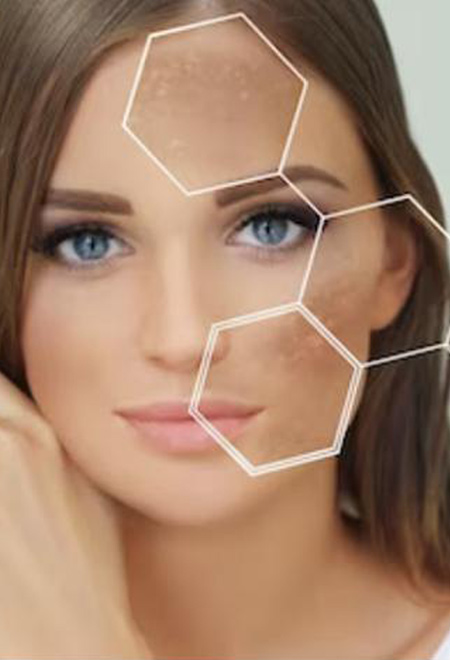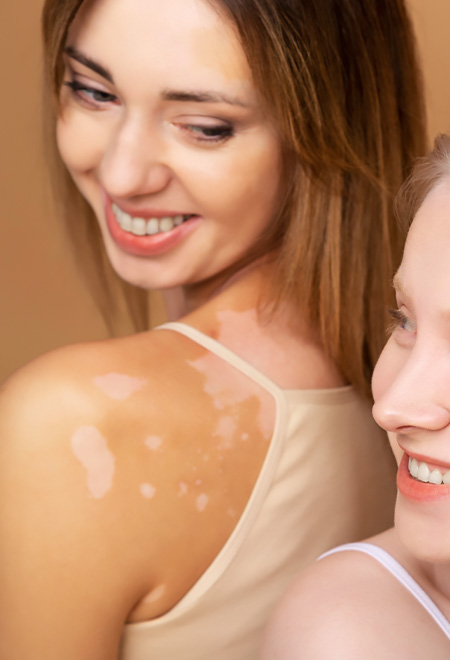Nişantaşı - İstanbul

Skin Spots and Treatments
Melasma and Spots Treatment addresses a skin condition known as melasma, characterized by the development of brown or blue-gray patches or spots like freckles on the skin. Typically associated with pregnancy, melasma results from overproduction of skin coloration cells. This common condition has various available treatments, effectively diminishing the appearance of these patches and spots in a short period.
Feel Free to Reach Out to Us for Melasma and Spot Treatment!
CONTACT USWhat is Melasma?
Melasma is the formation of black or brown patches on the skin, resulting from the excessive production of melanin by melanocyte cells. Melanocytes are cells responsible for producing and accumulating pigment in the skin. Characterized by skin discoloration or hyperpigmentation, melasma commonly appears on the face, particularly on the forehead, cheekbones, chin, and upper lip. Additionally, melasma may develop on other sun-exposed areas of the body. When observed during pregnancy, it is often referred to as the “pregnancy mask” or “chloasma”.
Racial and hereditary factors play a significant role in the development of melasma, with individuals having a hereditary predisposition facing a higher risk. This condition is more prevalent in women aged 20 to 50, particularly those with relatively darker skin tones, although approximately 10% of men may also develop melasma.
While the precise cause of melasma remains unknown, certain factors contribute to its onset. These include photosensitivity and prolonged sun exposure, hormonal fluctuations, hormone-based treatments (such as estrogen, progesterone, and thyroid medications), antibiotics, antidepressants, birth control pills, chemical cosmetics, skin applications like lemon or baking soda, irritating hair removal methods like waxing or depilation, mechanical peels, and certain herbal teas. These factors are known to increase melanin production, contributing to the formation of melasma.

How Many Types of Melasma Exist?
Epidermal melasma involves an excessive accumulation of melanin pigment in the outer layers of the skin. In dermal melasma, melanin-digesting cells known as melanophages are distributed across multiple layers of the skin. Mixed melasma is a combination of both epidermal and dermal types. While treatments such as laser therapy, chemical peels, and creams can lead to the disappearance of melasma in many cases, achieving desired results can be challenging in some instances.
Melasma is categorized into two types:
– Stable melasma
– Unstable melisma
Similarly, acne manifests in various types, each requiring specific acne treatments.
Stable Melasma
Stable melasma refers to excessive skin pigmentation resulting from a single event or trauma that triggers increased melanin production in a specific area of the face. For instance, hormonal changes during pregnancy may lead to melasma, commonly known as the ‘pregnancy mask’. This type of melasma is generally less influenced by factors such as sun exposure.
Unstable Melasma
Unstable melasma is often associated with an underlying systemic and persistent physiological condition that causes unexplained facial hyperpigmentation. This form of melasma tends to worsen with minor provocation.
Stable melasma is generally more responsive to treatment compared to unstable melasma, boasting a typical response rate of 90% with minimal recurrence.


Why Does Melasma Occur?
Melasma occurs due to an excess of a pigment called melanin beneath the skin, leading to the formation of patches. Melanin is responsible for the color of our skin and is synthesized by melanocytes, specialized cells. When these melanocytes produce an excessive amount of melanin, it results in the development of spots characteristic of melasma.
The overproduction of melanin by melanocytes, leading to increased pigmentation and conditions such as melasma, can be attributed to various factors, including;
• Hereditary Predisposition,
• Sun (Ultraviolet) Rays,
• Pregnancy, Hormone Therapy and Birth Control Pills,
• Cosmetic Products.
What Are The Treatment Options For Melasma?
Melasma can be treated through various methods, and the effectiveness of the treatment may vary. Melasma occurring during pregnancy or due to birth control pills may resolve spontaneously after the hormonal changes subside. However, for some individuals, melasma may persist for years or even a lifetime. Several treatment options are available to address and manage melasma:
Melasma Treatments
Hydroquinone
Hydroquinone is a widely used medication for treating melasma, applied topically to the skin. While over-the-counter formulations with the same active ingredient are available, they typically contain a lower concentration of hydroquinone compared to prescription-strength products recommended by dermatologists.
Tretinoin and coricosteroids
They are commonly recommended as secondary medications to complement the primary treatment for achieving a lighter skin color in melasma management.
Other topical medications
Additional topical medications, such as azelaic acid or kojic acid, may be prescribed as part of the treatment regimen for melasma.

Other Melasma Treatments
If topical medications fail to eliminate melasma, alternative methods such as chemical peels, microdermabrasion, dermabrasion, laser treatments, or light-based therapies may be considered. These interventions should be administered by a specialized dermatologist. It is crucial to select a treatment method that aligns with the patient’s skin type, as inappropriate choices may lead to more serious skin issues.
Frequently Asked Questions
What Potential Side Effects Should Be Considered During Melasma Treatment?
Melasma treatments, whether through medication or other methods, may have associated side effects. It is crucial to exercise caution and be mindful of any symptoms that may arise when undergoing a new treatment. Sensations such as irritation, tingling, and mild anxiety are common reactions to novel methods and are not necessarily indicative of a problem.
However, if you encounter skin irritation or notice darkening of the skin following a treatment, it is advisable to contact your doctor promptly for detailed information about the procedure and to address any concerns or potential complications.
What is the Typical Duration of Melasma Treatment?
Melasma treatment typically requires several months to show noticeable improvement. Adhering to the recommendations provided by your dermatologist is crucial for enhancing treatment effectiveness and minimizing potential side effects. For some individuals, ongoing treatment may be necessary even after melasma has disappeared, a phase referred to as post-treatment follow-up.
